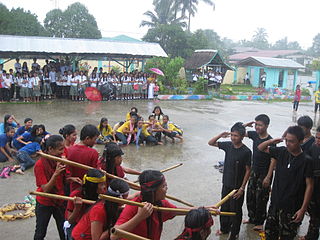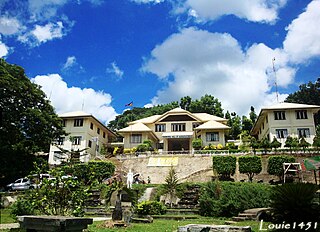Related Research Articles

Zamboanga del Sur, officially the Province of Zamboanga del Sur, is a province in the Philippines located in the Zamboanga Peninsula region in Mindanao. Its capital is the city of Pagadian. Statistically grouped with Zamboanga del Sur is the highly urbanized City of Zamboanga, which is geographically separated and a chartered city and governed independently from the province.

Zamboanga Sibugay, officially the Province of Zamboanga Sibugay, is a province in the Philippines located in the Zamboanga Peninsula region in Mindanao. Its capital is Ipil and it borders Zamboanga del Norte to the north, Zamboanga del Sur to the east and Zamboanga City to the southwest. To the south lies Sibuguey Bay in the Moro Gulf.

Lakewood, officially the Municipality of Lakewood, is a 4th class municipality in the province of Zamboanga del Sur, Philippines. According to the 2020 census, it has a population of 21,559 people.

Pagadian, officially the City of Pagadian, is a 1st class component city and the capital of the province of Zamboanga del Sur, Philippines. It is the regional center of Zamboanga Peninsula and the second-largest city in the region and in the province, after the independent city of Zamboanga. According to the 2020 census, it has a population of 210,452 people. The city will be converted to a highly urbanized city by the virtue of Proclamation No. 1247, signed by President Rodrigo Duterte dated November 8, 2021.

Kabasalan, officially the Municipality of Kabasalan, is a 2nd class municipality in the province of Zamboanga Sibugay, Philippines. According to the 2020 census, it has a population of 46,884 people.

Sindangan, officially the Municipality of Sindangan, is a 1st class municipality in the province of Zamboanga del Norte, Philippines. According to the 2020 census, it has a population of 103,952 people.

Dumingag, officially the Municipality of Dumingag, is a 2nd class municipality in the province of Zamboanga del Sur, Philippines. According to the 2020 census, it has a population of 48,881 people.

Guipos, officially the Municipality of Guipos, is a 4th class municipality in the province of Zamboanga del Sur, Philippines. According to the 2020 census, it has a population of 21,738 people.

Kumalarang, officially the Municipality of Kumalarang, is a 4th class municipality in the province of Zamboanga del Sur, Philippines. According to the 2020 census, it has a population of 29,479 people.

Lapuyan, is a 3rd class municipality in the province of Zamboanga del Sur, Philippines. According to the 2020 census, it has a population of 27,737 people. The municipality of Lapuyan is located in the southern section of the Zamboanga del Sur province. It is also often referred to as "Little America".

Margosatubig, officially the Municipality of Margosatubig, is a 3rd class municipality in the province of Zamboanga del Sur, Philippines. According to the 2020 census, it has a population of 38,660 people.

Midsalip, officially the Municipality of Midsalip, is a 4th class municipality in the province of Zamboanga del Sur, Philippines. According to the 2020 census, it has a population of 33,711 people.

Tigbao, officially the Municipality of Tigbao, is a 5th class municipality in the province of Zamboanga del Sur, Philippines. According to the 2020 census, it has a population of 21,675 people.

The Subanon is an indigenous group to the Zamboanga peninsula area, particularly living in the mountainous areas of Zamboanga del Sur and Misamis Occidental, Mindanao Island, Philippines. The Subanon people speak Subanon languages. The name is derived from the word soba or suba, a word common in Sulu, Visayas, and Mindanao, which means "river", and the suffix -nun or -non, which indicates a locality or place of origin. Accordingly, the name Subanon means "a person or people of the river". These people originally lived in the low-lying areas. However, due to disturbances and competitions from other settlers like the Moros, and migrations of Cebuano speakers and individuals from Luzon and other parts of Visayas to the coastal areas attracted by the inviting land tenure laws, further pushed the Subanon into the interior.
The Subanen languages are a group of closely related Austronesian languages belonging to the Greater Central Philippine subgroup. Subanen languages are spoken in various areas of Zamboanga Peninsula, namely the provinces of Zamboanga Sibugay, Zamboanga del Norte and Zamboanga del Sur, and in Misamis Occidental of Northern Mindanao. There is also a sizeable Subanen community in Misamis Oriental. Most speakers of Subanen languages go by the name of Subanen, Subanon or Subanun, while those who adhere to Islam refer to themselves as Kolibugan, "Kalibugan", "Tewlet" or "Telet".
Pangasi, also known as pangase or gasi, are various traditional Filipino rice wines from the Visayas Islands and Mindanao. They could also be made from other native cereals like millet and job's tears. Pangasi and other native Filipino alcoholic beverages made from cereal grains were collectively referred to by the Spanish as pitarrillos.

The term Paramount Ruler, or sometimes Paramount Datu, is a term used by historians to describe the highest ranking political authorities in the largest lowland polities or inter-polity alliance groups in early Philippine history, most notably those in Maynila, Tondo, Pangasinan, Cebu, Bohol, Butuan, Cotabato, and Sulu.

Thimuay is the name of the most senior ancestral leader among the Subanon people of the Zamboanga Peninsula in the Philippines. Less senior ancestral leaders are called "datu", just as they are elsewhere in the Philippines. Thimuay is equivalent to the titles "lakan", "sultan", or "rajah" in other Philippine cultures.

Buklog is a cultural tradition from the Philippines in the form of a thanksgiving ritual practiced by the Subanen people who live on the Zamboanga Peninsula, the southern part of the Philippines. This ritual system is carried out as a form of gratitude to the spirits for positive life experiences, such as abundant harvests, recovery from an illness or calamity, or recognition of newly appointed leaders.
References
- 1 2 "About Lapuyan: Facts and Profile". lapuyan.gov.ph. Local Government Unit of Lapuyan. Archived from the original on 2017-02-24. Retrieved 2017-07-14.
- 1 2 Apatan-Lusay, Kimberly F. (December 2020). "Thimuay Mbeng and the Imbing Clan: Their Role in the Christianization of the Subanen in Lapuyan, Zamboanga Peninsula (1912-1946)". Academia Lasalliana Journal of Education and Humanities. 2: 35–49.
- ↑ Elago, Marilou C.; Dando, Rhea Felise A.; Pizon, Jhoan Rhea L.; Galang, Rainier M.; Sia, Isidro C. "Phase II Documentation of Philippine Traditional Knowledge and Practices on Health and Development of Traditional Knowledge Digital Library on Health for Selected Ethnolinguistic Groups: The SUBANEN people of Salambuyan, Lapuyan, Zamboanga del Sur". Philippine Traditional Knowledge Digital Library on Health. Archived from the original on 2021-09-27. Retrieved 2021-09-27.